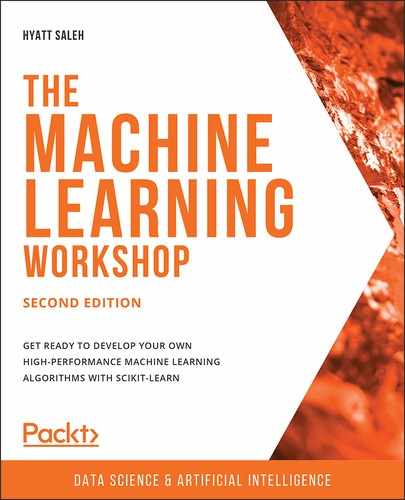Book Description
Take a comprehensive and step-by-step approach to understanding machine learning
Key Features
- Discover how to apply the scikit-learn uniform API in all types of machine learning models
- Understand the difference between supervised and unsupervised learning models
- Reinforce your understanding of machine learning concepts by working on real-world examples
Book Description
Machine learning algorithms are an integral part of almost all modern applications. To make the learning process faster and more accurate, you need a tool flexible and powerful enough to help you build machine learning algorithms quickly and easily. With The Machine Learning Workshop, you'll master the scikit-learn library and become proficient in developing clever machine learning algorithms.
The Machine Learning Workshop begins by demonstrating how unsupervised and supervised learning algorithms work by analyzing a real-world dataset of wholesale customers. Once you've got to grips with the basics, you'll develop an artificial neural network using scikit-learn and then improve its performance by fine-tuning hyperparameters. Towards the end of the workshop, you'll study the dataset of a bank's marketing activities and build machine learning models that can list clients who are likely to subscribe to a term deposit. You'll also learn how to compare these models and select the optimal one.
By the end of The Machine Learning Workshop, you'll not only have learned the difference between supervised and unsupervised models and their applications in the real world, but you'll also have developed the skills required to get started with programming your very own machine learning algorithms.
What you will learn
- Understand how to select an algorithm that best fits your dataset and desired outcome
- Explore popular real-world algorithms such as K-means, Mean-Shift, and DBSCAN
- Discover different approaches to solve machine learning classification problems
- Develop neural network structures using the scikit-learn package
- Use the NN algorithm to create models for predicting future outcomes
- Perform error analysis to improve your model's performance
Who this book is for
The Machine Learning Workshop is perfect for machine learning beginners. You will need Python programming experience, though no prior knowledge of scikit-learn and machine learning is necessary.
Table of Contents
- The Machine Learning Workshop
- Second Edition
- Preface
- 1. Introduction to Scikit-Learn
- 2. Unsupervised Learning – Real-Life Applications
- Introduction
- Clustering
- Exploring a Dataset – Wholesale Customers Dataset
- Data Visualization
- Loading the Dataset Using pandas
- Visualization Tools
- Exercise 2.01: Plotting a Histogram of One Feature from the Circles Dataset
- Activity 2.01: Using Data Visualization to Aid the Pre-processing Process
- k-means Algorithm
- Understanding the Algorithm
- Exercise 2.02: Importing and Training the k-means Algorithm over a Dataset
- Activity 2.02: Applying the k-means Algorithm to a Dataset
- Mean-Shift Algorithm
- DBSCAN Algorithm
- Evaluating the Performance of Clusters
- Summary
- 3. Supervised Learning – Key Steps
- Introduction
- Supervised Learning Tasks
- Model Validation and Testing
- Evaluation Metrics
- Evaluation Metrics for Classification Tasks
- Exercise 3.03: Calculating Different Evaluation Metrics on a Classification Task
- Choosing an Evaluation Metric
- Evaluation Metrics for Regression Tasks
- Exercise 3.04: Calculating Evaluation Metrics on a Regression Task
- Activity 3.02: Evaluating the Performance of the Model Trained on a Handwritten Dataset
- Error Analysis
- Summary
- 4. Supervised Learning Algorithms: Predicting Annual Income
- 5. Supervised Learning – Key Steps
- 6. Building Your Own Program
- Appendix
- 1. Introduction to Scikit-Learn
- 2. Unsupervised Learning – Real-Life Applications
- Activity 2.01: Using Data Visualization to Aid the Pre-processing Process
- Activity 2.02: Applying the k-means Algorithm to a Dataset
- Activity 2.03: Applying the Mean-Shift Algorithm to a Dataset
- Activity 2.04: Applying the DBSCAN Algorithm to the Dataset
- Activity 2.05: Measuring and Comparing the Performance of the Algorithms
- 3. Supervised Learning – Key Steps
- 4. Supervised Learning Algorithms: Predicting Annual Income
- 5. Artificial Neural Networks: Predicting Annual Income
- 6. Building Your Own Program
